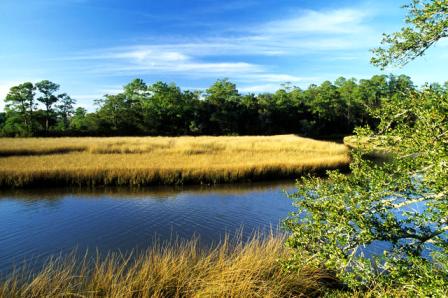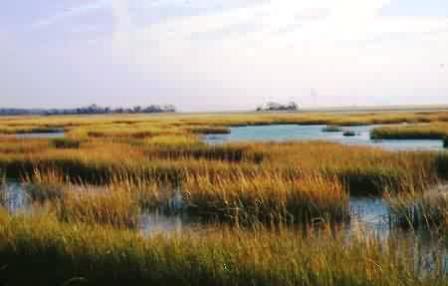Discover Florida Nature
It's time to explore the natural Florida


|
|
|
|
|
 Salt
marshes are part of the Coastal Ecosystem. Florida's coastal ecosystems
are one of the greatest assets that Florida has. With more coastline
than any other state in the contiguous United States, they are a source
of both economic, environmental and recreational benefit. People come
from all over the world to visit the beautiful Florida beaches. In
addition to people
sea turtles also come from all over the world to lay their eggs on
Florida's Atlantic coast, one of only a handful of places in the world
that they come. Salt marshes are coastal wetlands rich in marine life.
They are sometimes called tidal marshes, because they occur in the zone
between low and high tides. Salt marsh plants cannot grow where waves
are strong, but they thrive along low-energy coasts. Salt
marshes are part of the Coastal Ecosystem. Florida's coastal ecosystems
are one of the greatest assets that Florida has. With more coastline
than any other state in the contiguous United States, they are a source
of both economic, environmental and recreational benefit. People come
from all over the world to visit the beautiful Florida beaches. In
addition to people
sea turtles also come from all over the world to lay their eggs on
Florida's Atlantic coast, one of only a handful of places in the world
that they come. Salt marshes are coastal wetlands rich in marine life.
They are sometimes called tidal marshes, because they occur in the zone
between low and high tides. Salt marsh plants cannot grow where waves
are strong, but they thrive along low-energy coasts.SUBSTRATE: Brackish, often waterlogged, largely anaerobic, sandy sediment. TOPOGRAPHY: Relatively flat, intertidal areas on, or sloping up slightly from, permanent water edge. VEGETATION / ALGAE: Nonwoody, salt-tolerant plants; principal species are smooth cordgrass (on Atlantic side) and black needlerush; above mean high water level are numerous vascular plant species in addition to black needlerush; several hundred species of benthic microalgae and phytoplankton; a few species of large, multicellular seaweeds; occasional mangroves in warmer areas. FAUNA: Abundant food and cover for resident and transient animals; nursery grounds for many fish and shellfish of commercial and recreational importance; many visiting birds and three exclusive residents—clapper rails, long-billed marsh wrens, and seaside sparrows PROCESSES / DYNAMICS / ABIOTIC FACTORS: Rate of net primary production of organic matter among highest of any global ecosystem; aerial habitat above water dominated by marsh grasses and insect / spider / bird food webs. NEGATIVE IMPACTS: Most extensive impact has been from water impoundment and ditching for mosquito control; The elimination and alteration of Florida salt marshes have a negative effect on fishery resources. It is estimated that in Florida at least 60,000 acres, or 8 percent, of estuarine habitat has been lost to permitted dredge and fill activities.  Salt
marshes are composed of a variety of plants: rushes, sedges, and
grasses. Florida's dominant salt marsh species include: black needle
rush, the grayish rush occurring along higher marsh areas; saltmeadow
cord grass, growing in areas that are periodically inundated; smooth
cord grass, found in the lowest areas that are most frequently
inundated; and sawgrass, which is actually a freshwater plant that
sometimes grows along the upper edges of salt marshes. All are tolerant
of the salt in sea spray. Salt
marshes are composed of a variety of plants: rushes, sedges, and
grasses. Florida's dominant salt marsh species include: black needle
rush, the grayish rush occurring along higher marsh areas; saltmeadow
cord grass, growing in areas that are periodically inundated; smooth
cord grass, found in the lowest areas that are most frequently
inundated; and sawgrass, which is actually a freshwater plant that
sometimes grows along the upper edges of salt marshes. All are tolerant
of the salt in sea spray. Salt marshes are important for many reasons. Hidden within the tangle of salt marsh plants are animals in various stages of life. Animals can hide from predators in marsh vegetation, because the shallow brackish area physically excludes larger fish. Many of Florida's popular marine fisheries species spend the early part of their lives protected in salt marshes. Young fish often have a varied diet, foraging for food in the mud of the marsh bottom, on the plants themselves, and on smaller organisms that also dwell in the marsh system. As salt marsh plants die and decompose, they create organic detritus, another food source for many marsh dwellers. Tidal waters move up into the marsh and then retreat, distributing detritus throughout the estuary. Algae are also an important food source in salt marshes. Salt marshes form along the margins of many north Florida estuaries. Gulf coast salt marshes occur along low energy shorelines, at the mouth of rivers, and in bays, bayous, and sounds. The Panhandle region west of Apalachicola Bay consists mainly of estuaries with few salt marshes. However, from Apalachicola Bay south to Tampa Bay, salt marshes are the main form of coastal vegetation. The coastal area known as "Big Bend" has the greatest salt marsh acreage in Florida, extending from Apalachicola Bay to Cedar Key. South of Cedar Key salt marshes begin to be replaced by mangroves as the predominant intertidal plants. On the Atlantic coast, salt marshes occur from Daytona Beach northward. |
|
|
Advertise | Privacy Statement | Dog Encyclopedia | Video |Contact | Alaska Nature |
|